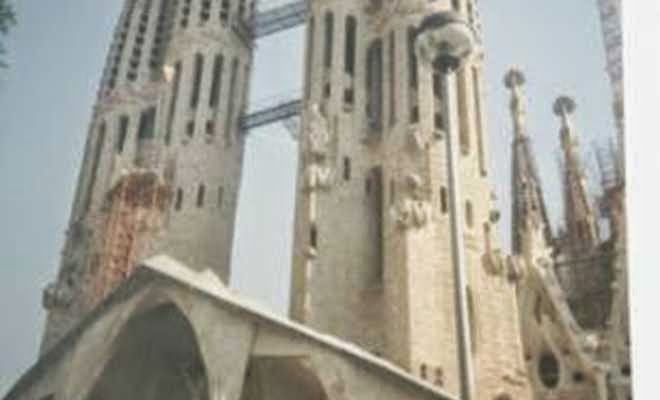La
Templo Expadori de la Sagrada Familia is one of the must-see's of Barcelona. Its
great towers puncture the cities skyline and have been referred to
"celestial billiard cue's" or "perforated cigars" and its
weird modernist facade is the symbol of Barcelona and is known the world over.
No visit to the city is complete without viewing Gaudi's masterpiece and no one
person interprets it the same. I combined a visit here with a wander in the
Museu de Catalunya, which along with the Sagrada Familia, is a source of
Catalan pride.
The Templo has
its own metro station on the yellow line and getting there won't cost you any
more then 150 pesetas, or you can walk there from anywhere in the Eixample and
take in Gaudi's other creations such as Casa Mila and the Parc Guell. The
templo is the creation of one man, Antoni Gaudi, who started his lifes work in
1890. He lived on site until his death in 1926 and each successive generations
leaving their mark on this unique building. When you leave the subway station
the western facade of the Templo immediately comes into sight. Try and cross
the road to the small plaza directly opposite as there is a better view of the
coffee-brown towers reaching into the sky. Each tower is topped with a jewel-like
star and its stark modernist profile is topped with surreal carvings and
angles. Was there a touch of madness in the make-up of Gaudi to create such a
building?
The best advice
I can give you once you have paid your 500 pesetas is to head for the
elevators. If you don't, you will go through the interior of the Templo very
quickly and before you know it you will have finished. You will have to join
another queue but once you reach the top there are fantastic views of Barcelona
reaching down to the sparkling mediterrean. Once back down, the interior of the
catedral is very disappointing. Sunlight will illuminate a vast dusty
construction site where only sections of the completed modernist ceiling can be
seen.
What you forget
is that cathedrals take hundreds of years to build (York Minster took 150)and
what we are seeing now is part of the process, best to come back in 2026 and
see it when it is completed. To get the most of out of a visit have a look at
the museu (museum). Here are Gaudis original sketches, models of the finished
version (with towers in the centre as well, making it look like a porcupine)and
a workshop where stonemasons worked upon detailed carvings.
After a lunch of
sangria and paella I checked out the recommended Museu Catalunya. Situated on the Moll D'Espanya this is housed in
an old warehouse and is a good museum telling the story of a country within a
country. Nationalism makes me nervous, but this was a intelligent museum, and
if the Catalans had a talent for picking the wrong side during their history -
it certainly showed here. This was a museum made by Catalans for Catalans and
there was very little in Castilean, let alone English. But they will give you a
guidebook in your native language and allow you to explore the high-tech exhibits.
First, the
Romans built Barcelona then it became part of the Caliphate of Cordoba only
freed after the reconquisita. You were allowed to explore Moorish and Medieval
Spain on CD-Rom's and audio-visual exhibits. It was only an independent country
for a 100 years before being swallowed up by Ferdinand and Isabella. But as
history progressed its talent for picking the wrong side showed. In the war of
Spanish succession it had the choice of a weak Spanish monarch or a strong
French one - it chose the weak Spanish one and had the bejesus cannoned out of
it by the winning French Bourbons. In the Spanish civil war it had the choice
of a weak republican army or a strong nationalist one - you can guess which one
it picked. Franco’s retaliation was particularly severe on Barcelona and
thousands headed for the French border.
I would
recommend this museum to anyone who wants to get at the bones of Barcelona.
Food for the mind, and a good interlude before you hit the nightspots of this
extraordinary city later on...










































